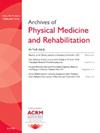Traumatic Brain Injury and Its Risk Factors in a Homeless Population
IF 3.6
2区 医学
Q1 REHABILITATION
Archives of physical medicine and rehabilitation
Pub Date : 2024-12-01
DOI:10.1016/j.apmr.2024.07.017
引用次数: 0
Abstract
Objective
To characterize the traumatic brain injury (TBI) profile and its associated risk factors in homeless individuals in Santa Clara County, CA.
Design
Observational cohort study.
Setting
Two homeless shelter health clinics in Santa Clara County, CA.
Participants
Currently or recently homeless individuals seeking health care at 2 homeless shelter health clinics between August 2013 and May 2014.
Interventions
Not applicable.
Main Outcome Measures
Demographics, TBI incidence and characteristics.
Results
The findings indicate that TBI history in the homeless population was higher (79.7%) than in the general population (12%). Almost half of the population (49.2%) reported that their TBI occurred before the age of 18. Of the participants, 68.2% reported sustaining a TBI with loss of consciousness. TBI caused by violence (60%) was lower in this cohort than other homeless cohorts but was the main cause of injury regardless of age. Alcoholism was a risk factor for having more TBIs. No differences in TBI profile were found between sexes.
Conclusions
Our findings underscore the need for more research on the lifetime risk factors associated with TBI to prevent and reduce the number of brain injuries in homeless populations.
无家可归人群的创伤性脑损伤及其风险因素。
目的:描述加利福尼亚州圣克拉拉县无家可归者的脑外伤概况及其相关风险因素:描述加利福尼亚州圣克拉拉县无家可归者的脑外伤概况及其相关风险因素:观察性队列研究 地点: :加利福尼亚州圣克拉拉县的两家无家可归者收容所健康诊所 参与者:2013 年 8 月至 2014 年 5 月期间在两家无家可归者收容所健康诊所就医的当前或近期无家可归者:主要结果测量:人口统计学、创伤性脑损伤发生率和特征 结果:研究结果表明,无家可归人群中的创伤性脑损伤病史(79.7%)高于普通人群(12%)。近一半的人群(49.2%)称他们的创伤性脑损伤发生在 18 岁之前。68.2%的参与者称其创伤性脑损伤导致意识丧失。与其他无家可归者群体相比,该群体中因暴力造成的创伤性脑损伤(60%)较少,但无论年龄大小,暴力都是造成创伤的主要原因。酗酒是造成更多创伤性脑损伤的风险因素。男女之间的创伤性脑损伤情况没有差异:我们的研究结果表明,有必要对与创伤性脑损伤相关的终生风险因素进行更多研究,以预防和减少无家可归人群中的脑损伤数量。
本文章由计算机程序翻译,如有差异,请以英文原文为准。
求助全文
约1分钟内获得全文
求助全文
来源期刊
CiteScore
6.20
自引率
4.70%
发文量
495
审稿时长
38 days
期刊介绍:
The Archives of Physical Medicine and Rehabilitation publishes original, peer-reviewed research and clinical reports on important trends and developments in physical medicine and rehabilitation and related fields. This international journal brings researchers and clinicians authoritative information on the therapeutic utilization of physical, behavioral and pharmaceutical agents in providing comprehensive care for individuals with chronic illness and disabilities.
Archives began publication in 1920, publishes monthly, and is the official journal of the American Congress of Rehabilitation Medicine. Its papers are cited more often than any other rehabilitation journal.

 求助内容:
求助内容: 应助结果提醒方式:
应助结果提醒方式:


